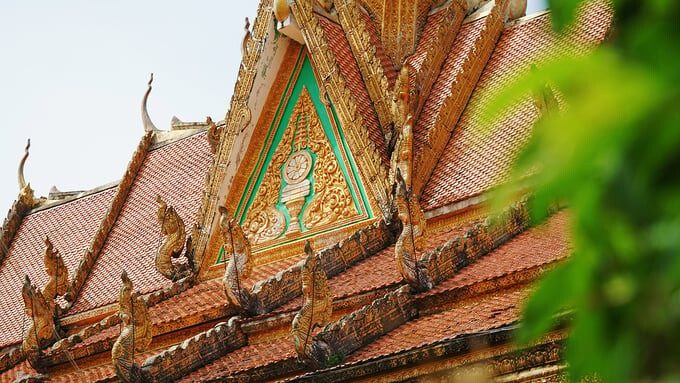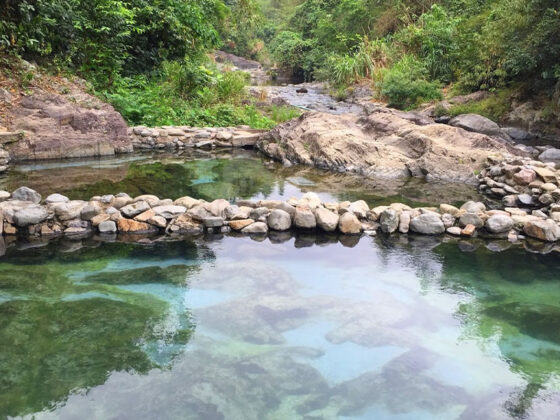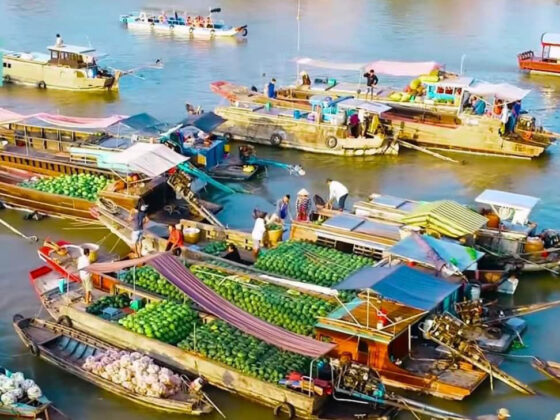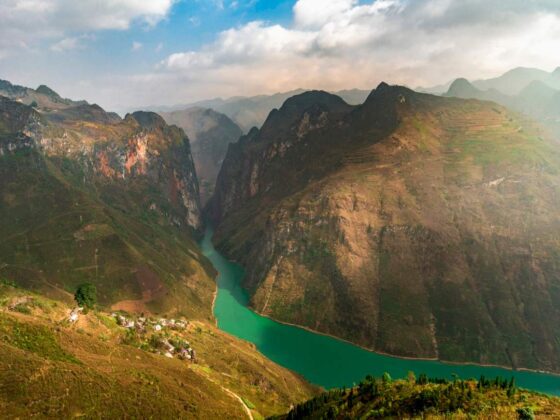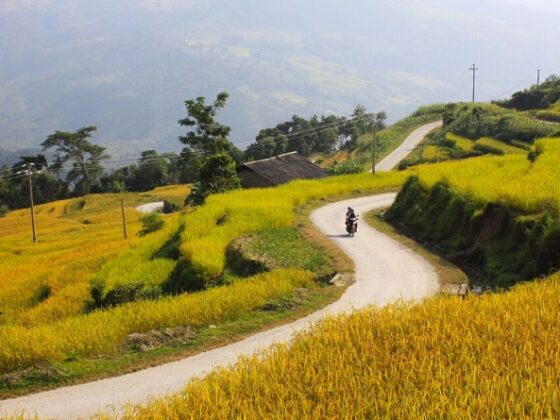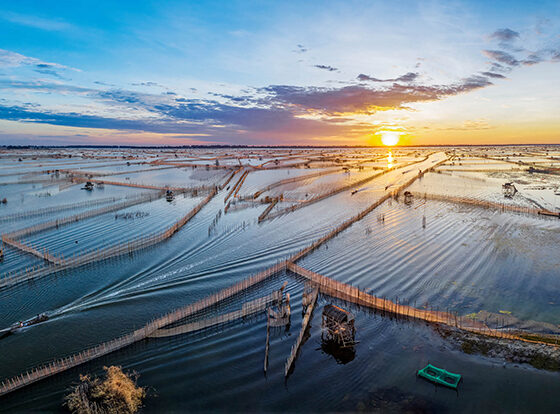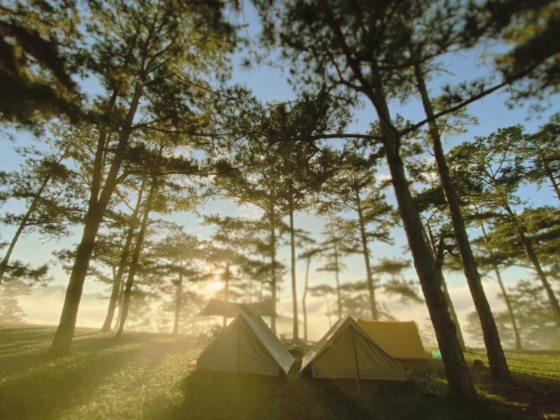Table of Contents Show
Welcome to Tri Tôn District, a unique land in the western part of An Giang Province, Vietnam. This area is not only famous for its endless rice fields and majestic mountains but also for preserving an invaluable cultural treasure of the Khmer people — 37 ancient and beautiful Khmer temples.
The Khmer temples here are more than places of worship; they are also cultural, educational, and spiritual centers for the local Khmer community. These temples play a vital role in preserving and promoting the unique cultural identity of the Khmer ethnic group in southern Vietnam.
Overview of the 37 Khmer Temples in Tri Tôn District
The Khmer temples are scattered throughout the district, mainly concentrated in communes such as Tri Tôn, An Tức, Ô Lâm, Cô Tô, Châu Lăng, Lương Phi, Ba Chúc, and Lê Trì. Each temple possesses its own distinct beauty, yet they share common architectural traits typical of Southern Khmer pagodas — curved roofs, intricate carvings of dragons and Naga serpents, and graceful Buddha statues.
Below is a list of the 37 temples, categorized by location:
| No. | Common Name | Khmer Name (Transliteration) | Meaning (Approx.) | Location |
| 1 | Xa Ton Pagoda (Chùa Trên) | Svay Ton | The clinging monkey | Tri Tôn Town |
| 2 | Chùa Dưới | Prey Veng | Ancient forest | |
| 3 | Ta Pa Pagoda (Mountain Pagoda) | Chon Phnom | Foot of the mountain | Núi Tô |
| 4 | Soai So Pagoda | Svay So | White mango | |
| 5 | Kor Treng Pagoda | Kor Treng | The stork perched on a treng tree | |
| 6 | Chrut Pot Pagoda | Chuos Pot | Bamboo stream | An Tức |
| 7 | Svay Ta Hon Pagoda | Svay Ta Hoong | Mango tree planted by Mr. Ta Hon | |
| 8 | Thmey Pagoda | Thmey | New temple | |
| 9 | Pang Trao Pagoda | Tro Peang Trao | Pond full of taro plants | |
| 10 | B52 Pagoda | Svay Don Kum | Clustered mango trees | Ô Lâm |
| 11 | Som Say Pagoda | Som Say | — | |
| 12 | Kup Lung Pagoda | Kom Plung | Kom Plung flower | |
| 13 | Bung Pagoda | Bung | Wetland area | |
| 14 | Pa Thes Pagoda | Preas Theat | Pagoda of Buddha relics | |
| 15 | Thnot Chrum Pagoda | Thnot Chrum | Clustered sugar palm trees | |
| 16 | Ta Mun Pagoda | Chrey Ta Mun | Cô Tô | |
| 17 | Phnom Triet Pagoda | Phnom Triet | Triet Mountain | |
| 18 | Suk Rin Tea Ram Pagoda | Suk Rin Tea Ram | Being restored | |
| 19 | Cha Day Pagoda | Po Les | Growing bodhi tree | |
| 20 | Chi Ka En Upper Pagoda | Tuk Phos | Rising water | Châu Lăng |
| 21 | Chi Ka En Lower Pagoda | Rum Dual Tual So Phi Ram | Beautiful cotton tree | |
| 22 | Nam Qui Upper Pagoda | Phnom Pi Ler | Two mountains | |
| 23 | Nam Qui Middle Pagoda | Phnom Pi Kandal | ||
| 24 | Nam Qui Lower Pagoda | Phnom Pi Krom | ||
| 25 | La Pagoda | Po Chom Roong | Name of a flower | |
| 26 | Hang Cong Pagoda | Krang Kroch | Hill of citrus trees | |
| 27 | Behind Hang Cong Pagoda | Tual Prasat | Tower hill | |
| 28 | Pang Ro Pagoda | Pong Gro | Wild mulberry | |
| 29 | Sa Lon Pagoda | Sro Lon | Mountain stream | Lương Phi |
| 30 | Ta Dung Upper Pagoda | Tum Puong Ler | Name of the Tum Puong tree | |
| 31 | Ta Dung Lower Pagoda | Tum Puong Krom | ||
| 32 | Ta Miet Upper Pagoda | Kok Ro Meat Ler | ||
| 33 | Ta Miet Lower Pagoda | Kok Ro Meat Krom | ||
| 34 | Sap Gia Pagoda | Onh Don Pen | Round well | Ba Chúc |
| 35 | Ang Pagoda | Ang | ||
| 36 | Soc Tuc Pagoda | Puas Tuc | Lê Trì | |
| 37 | Thlang Pagoda | Thlang |
Each Khmer temple carries its own history and spiritual significance, reflecting the Khmer people’s cultural heritage and beliefs. Visitors can plan their journey by grouping temples by area for a more convenient and fulfilling experience.
Highlight Temples
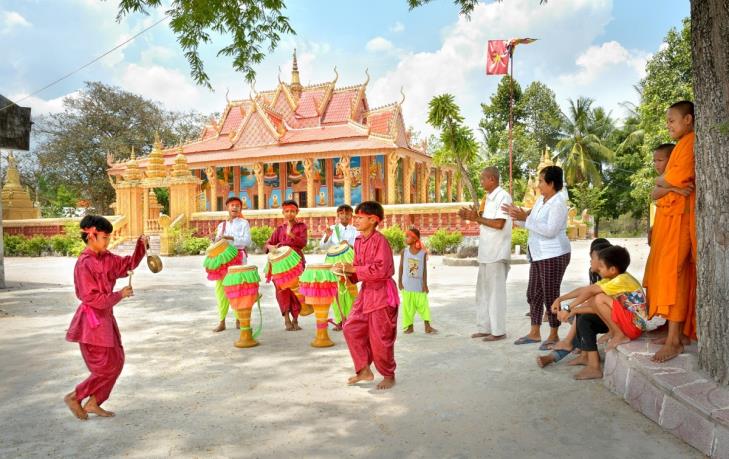
- Xa Ton Pagoda (Svay Ton): Located in the heart of Tri Tôn Town, Svay Ton — meaning “The Clinging Monkey” — is among the oldest and most beautiful temples in the region.
- Ta Pa (Mountain Pagoda): Perched on To Mountain, Ta Pa offers a majestic landscape and panoramic views of the surrounding plains.
- Soai So Pagoda (Svay So): Meaning “White Mango,” this temple captivates visitors with its intricate architecture and vivid murals depicting the life of the Buddha.
- Kor Treng Pagoda: Translated as “The Stork on the Treng Tree,” this Khmer temple is renowned for its vibrant Chol Chnam Thmay Festival (the Khmer New Year) held annually.
Visiting Guide
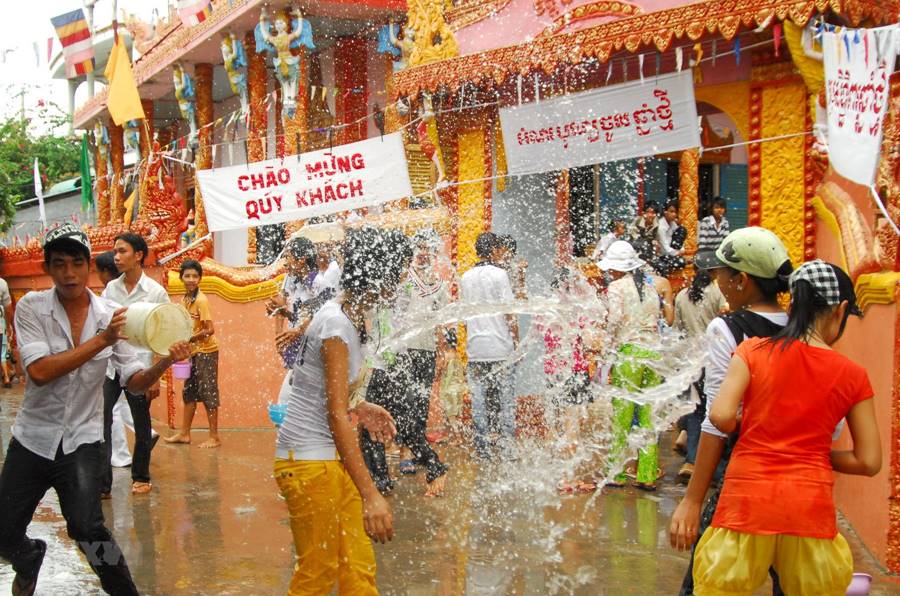
- Best time to visit: You can visit year-round, but the most pleasant period is from November to April, when the weather is cool and dry.
- How to get there: From Ho Chi Minh City, take a bus to Long Xuyên, then continue by local bus or rent a motorbike to explore Tri Tôn. Within the district, motorbikes are the most convenient way to travel between temples.
Things to remember:
- Dress modestly and respectfully.
- Remove shoes before entering the main hall.
- Ask for permission before taking photos inside.
- Keep noise to a minimum and respect ongoing rituals.
Cultural and Spiritual Significance
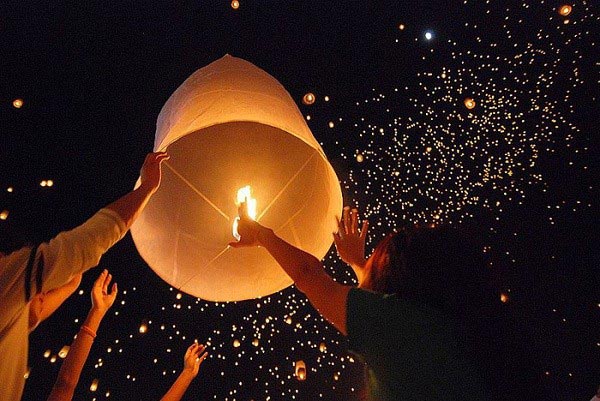
Khmer temples serve not only as religious sanctuaries but also as community centers for education and cultural events. They host important annual festivals such as Chol Chnam Thmay (Khmer New Year), Ok Om Bok (Moon Offering Festival), and Sene Dolta (Ancestor Worship Festival).
Chol Chnam Thmay marks the beginning of the Khmer New Year and is one of the most important traditional festivals. In An Giang, home to a large Khmer population, this celebration expresses gratitude to ancestors and prayers for peace, prosperity, and favorable weather in the coming year.
During the three festival days, locals perform traditional rituals such as bathing the Buddha, offering star blessings, and peace ceremonies to dispel misfortune and bring luck to their families. Colorful cultural activities — lion dances, drumming, and folk games — fill the Khmer temples with joyful energy, reinforcing community bonds and preserving the Khmer cultural identity.
Ok Om Bok, another major celebration, is held annually in the tenth lunar month. The festival honors the Moon for its blessings of abundant harvests and peaceful life. On this night, Khmer people gather at Khmer temples or riverbanks to float flower lanterns, praying for good fortune.
The highlight is the traditional boat race (Ghe Ngo) — a thrilling event that draws thousands of spectators and participants, radiating a strong spirit of unity and joy. The festival not only expresses gratitude toward nature but also takes place at Khmer temples, helping to sustain and promote Khmer cultural heritage through generations.
Conclusion
The 37 Khmer temples of Tri Tôn District, An Giang, form a priceless treasury of architecture, spirituality, and cultural heritage — not only for the province but for Vietnam as a whole.
Exploring these temples offers travelers an unforgettable experience, combining scenic beauty, architectural wonder, and deep cultural insight into the Khmer community of Southern Vietnam. Plan your trip today and discover the timeless charm of the Khmer temples in Tri Tôn — a journey full of meaning and tranquility.
Photos sourced from the An Giang Provincial Party Committee and Industry & Trade Magazine.
Join our vibrant community on Facebook to share your trekking stories and tips, and don’t forget to like the ExoTrails fanpage for the latest updates and exclusive offers!

